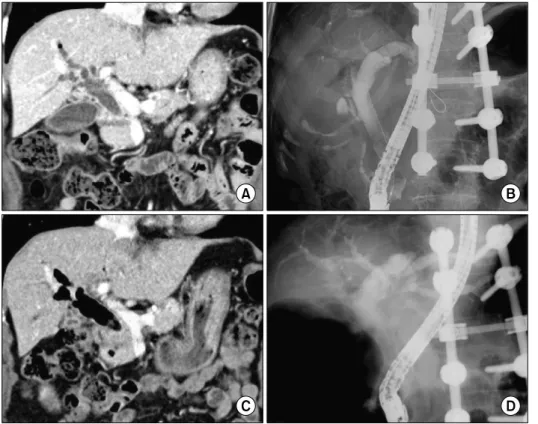Indication and surgical techniques of bypass
choledochojejunostomy for intractable choledocholithiasis
Shin Hwang
1, Dong-Hwan Jung
1, Sung Koo Lee
2, and Myung-Hwan Kim
2Departments of
1Surgery and
2Internal Medicine, Asan Medical Center, University of Ulsan College of Medicine, Seoul, Korea
Despite development in endoscopic treatment and minimally invasive surgery for choledocholithiasis, there remains a small number of patients who require bypass Roux-en-Y choledochojejunostomy (RYCJ) because of the intractable occurrence of common bile duct (CBD) stones. We herein present the detailed procedures of open RYCJ customized for intractable choledocholithiasis. The first method is a side-to-end choledochojejunostomy with intraluminal closure of the distal CBD. This method was applied to a 79-year-old female patient who underwent endoscopic retrograde cholangiopancreatography (ERCP) more than 10 times in the past 14 years (Case No. 1). The distal CBD was explored through choledochotomy and then the distal CBD lumen was occluded with internal running sutures. A large-sized choledochojejunostomy was performed. The patient recovered uneventfully and has been doing well for the past 2 years. The second method is an end-to-end choledochojejunostomy with segmental CBD resection. It was applied to a 75-year-old male patient who underwent ERCP 9 times in the past 10 years (Case No. 2). The CBD was resected segmentally and a large-sized choledochojejunostomy was performed. The patient also recovered uneventfully and has been doing well for the past 2 years. In conclusion, the primary indication of bypass RYCJ is intractable chol- edocholithiasis which requires numerous sessions of endoscopic stone removal over a long period. Open RYCJ is the preferred procedure to date. If the papilla is patulous, the distal CBD should be occluded or resected to prevent reflux ascending cholangitis. We recommend to resect the intrapancreatic distal CBD if it is markedly dilated like chol- edochal cyst. (Ann Hepatobiliary Pancreat Surg 2021;25:259-264)
Key Words: Choledochojejunostomy; Endoscopic retrograde cholangiopancreatography; Benign stricture; Reflux;
Ascending cholangitis
Received: November 1, 2020; Revised: November 15, 2020; Accepted: November 15, 2020 Corresponding author: Shin Hwang
Department of Surgery, Asan Medical Center, University of Ulsan College of Medicine, 88 Olympic-ro 43-gil, Songpa-gu, Seoul 05505, Korea Tel: +82-2-3010-3930, Fax: +82-2-3010-6701, E-mail: shwang@amc.seoul.kr
Copyright Ⓒ 2021 by The Korean Association of Hepato-Biliary-Pancreatic Surgery
This is an Open Access article distributed under the terms of the Creative Commons Attribution Non-Commercial License (http://creativecommons.org/
licenses/by-nc/4.0) which permits unrestricted non-commercial use, distribution, and reproduction in any medium, provided the original work is properly cited.



